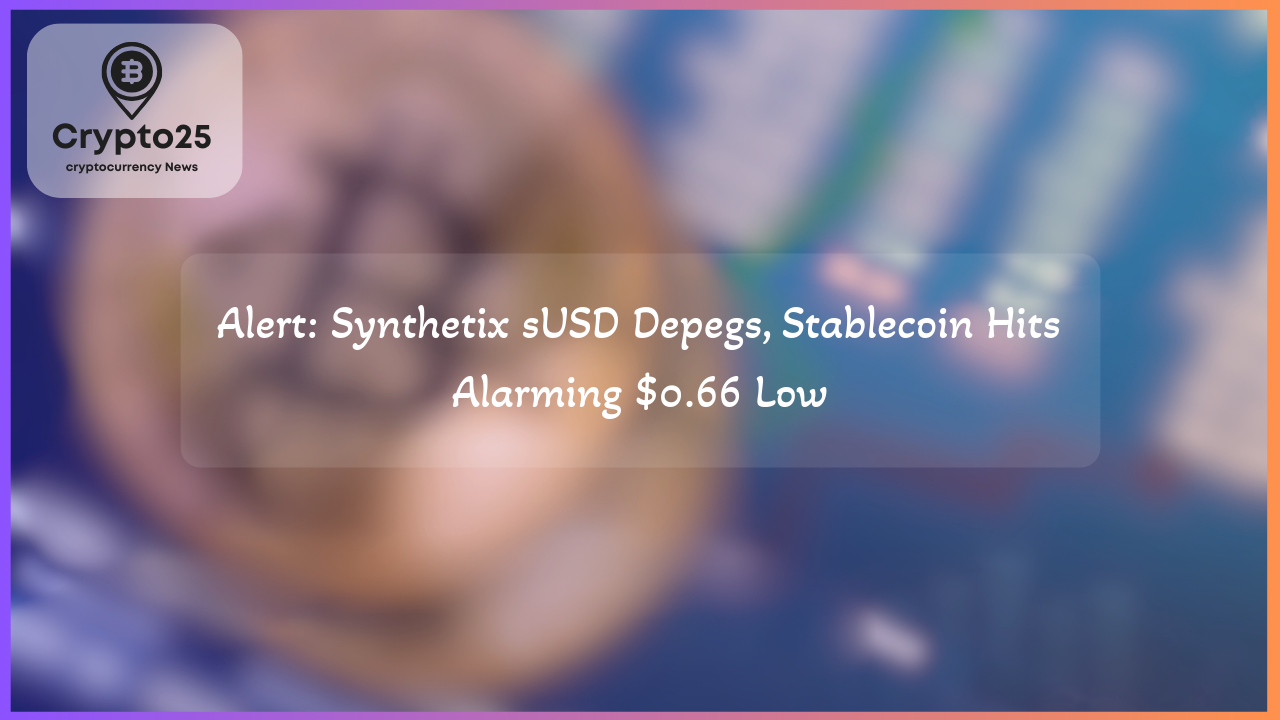
The sUSD stablecoin developed by Synthetix has garnered widespread attention recently as its peg to the US dollar has faced significant challenges. Once valued seamlessly at $1, this stablecoin has dropped to alarming lows, raising concerns within the DeFi ecosystem. As the Synthetix protocol undergoes critical changes, the stability of sUSD remains a focal point for traders and crypto enthusiasts globally.
Why sUSD Is Struggling to Maintain Stability
In recent weeks, the sUSD stablecoin has experienced volatility, plunging to $0.66—more than 30% below its $1 peg. This issue follows a month-long depegging trend that has led to uncertainties around the Synthetix protocol’s ability to restore balance quickly. What sets sUSD apart is its foundational nature: a fully crypto-collateralized stablecoin rather than an algorithmic one. However, recent upgrades intended to enhance efficiency may have inadvertently disrupted essential stabilizing mechanisms.
The depegging is linked to March’s SIP-420 protocol upgrade, which modified the way debt is managed within Synthetix. By transitioning to a shared debt pool and reducing the collateralization ratio from 750% to 200%, the system effectively reduced stakers’ direct incentive to defend the peg. Stablecoin volatility ensued, with sUSD hitting $0.98 on March 20 and falling further to $0.91 at the month’s end. Critics argue that the restructured design, while boosting capital efficiency, sacrificed robust peg-maintaining mechanisms, leaving the stablecoin vulnerable to external pressures.
Examining the Impact of the SIP-420 Upgrade on sUSD
The recent instability of sUSD can be directly attributed to the sweeping changes brought by SIP-420. The objective of this upgrade was to increase capital efficiency within the ecosystem by introducing a shared debt pool. While this move aimed to optimize the use of staked SNX (Synthetix Network Token) collateral, it seems to have removed a key stabilization factor: incentivized buying of low-priced sUSD to reduce overall debt.
In this new design, liquidity for sUSD became thinner, as highlighted by blockchain analyst Mrinal Thakur. According to Thakur, Automated Market Maker (AMM) pools are skewed heavily toward sUSD, making the token more susceptible to steep price fluctuations when trading volumes increase. Furthermore, the reduced collateralization ratio has made the system less resilient, prompting fears of cascading sell-offs as larger stakeholders withdraw from the ecosystem. These challenges, combined with the fragile liquidity environment, leave the protocol exposed to growing volatility and further depegging risks.
Despite these pressing issues, Synthetix founder Kain Warwick confidently maintains that the current instability is temporary. Warwick asserts that mechanisms designed to restore the peg are still evolving, believing the Synthetix ecosystem will weather the ongoing turbulence. He has even increased his personal SNX holdings, signaling his confidence in the platform’s recovery efforts.
The Road Ahead for sUSD: A Balancing Act for Synthetix
To address its challenges, Synthetix has rolled out both immediate and long-term solutions aimed at restoring confidence in sUSD. In the short term, the protocol is enhancing liquidity through Curve pools and incentivizing users on its derivatives exchange, Infinex. These measures are designed to counteract the stablecoin’s price swings by injecting much-needed liquidity into the market.
On a medium-term horizon, Synthetix has introduced "debt-free" staking mechanisms to incentivize individual debt repayment. This approach aims to stabilize sUSD’s price by making it advantageous for users to hold and trade the token, rather than liquidating it during periods of uncertainty. For its long-term strategy, Synthetix plans to tighten control over the sUSD supply while implementing additional adoption incentives across its growing product lineup.
While these efforts are promising, analysts remain cautious. The Synthetix treasury holds $30 million in reserve assets, including sUSD, USDC, and OP tokens. However, the ecosystem is still described as "fragile," with many questioning whether these reserves are sufficient in the event of another major market sell-off or broader DeFi downturn. The success of the protocol now largely hinges on the effectiveness of its multi-phase recovery plan.
| Key Metrics | Details |
|---|---|
| Market Cap | $1.2 Trillion |
| Collateral Ratio | Reduced from 750% to 200% |
| Treasury Reserves | $30 Million (sUSD, USDC, OP) |
Warwick acknowledges the uphill battle, advising holders to brace for the possibility of further volatility before stability is fully restored. His optimism, coupled with the technical enhancements underway, suggests that Synthetix is determined to resolve the systemic issues affecting sUSD and safeguard its role within the DeFi landscape.
The turbulence surrounding sUSD serves as a reminder of both the resiliency and risks inherent in decentralized finance. As Synthetix fine-tunes its mechanisms, stakeholders across the crypto space will be closely monitoring its progress. For now, the protocol’s ability to adapt to evolving market conditions may determine whether sUSD regains its footing or continues to struggle amid mounting challenges.
